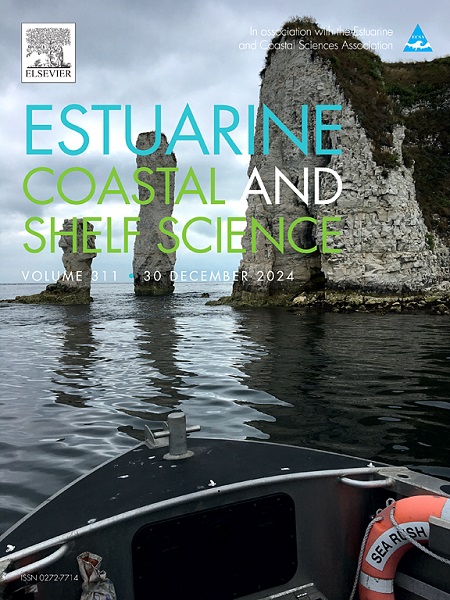Understanding saltmarsh distribution and mangrove co-occurrence at tropical estuaries
IF 2.6
3区 地球科学
Q1 MARINE & FRESHWATER BIOLOGY
引用次数: 0
Abstract
Saltmarshes are coastal ecosystems composed of herbaceous vegetation that provide nursery grounds for several estuarine species, coastal protection by wave attenuation, carbon sinks, and facilitate mangrove propagules establishment and survival. Saltmarshes are studied mainly in high-latitude estuarine regions of developed countries, while in tropical systems, saltmarshes are widely overlooked due to the dominance of mangrove forests. This study aimed to map the occurrence of saltmarshes in three tropical estuaries and assess mangrove propagules and seedlings within tropical Spartina spp. dominated saltmarshes. We tested the hypotheses that (1) the abundance of propagules and seedlings within saltmarshes would be higher than in non-vegetated intertidal flats and (2) mangrove propagules and seedlings abundance would be higher in denser and taller saltmarshes. Mangrove propagules and seedlings of Avicennia spp., Laguncularia racemosa, and Rhizophora mangle were mainly found within saltmarshes when compared to non-vegetated adjacent tidal flats. There was no significant effect of saltmarsh height and density on mangrove seedling abundance. The present study showed that saltmarsh facilitates mangrove colonization in mangrove-dominated regions. Future studies on tropical estuaries should assess if mangrove propagules and seedlings found on saltmarsh patches achieve the reproductive phase and promote the progradation of mangrove forests.
了解热带河口盐沼分布和红树林共生
盐沼是由草本植被组成的海岸生态系统,为一些河口物种提供了苗圃,通过波浪衰减和碳汇保护海岸,并促进红树林繁殖体的建立和生存。盐沼的研究主要集中在发达国家的高纬度河口地区,而在热带系统中,由于红树林占主导地位,盐沼被广泛忽视。本研究旨在绘制三个热带河口的盐沼分布图,并对热带米草属盐沼中红树林的繁殖体和幼苗进行评估。我们验证了以下假设:(1)盐沼中繁殖体和幼苗的丰度高于无植被的潮间带;(2)红树林繁殖体和幼苗的丰度在密度更高的盐沼中更高。与邻近无植被的滩地相比,盐沼中主要发现了红树的繁殖体和幼苗,其中Avicennia spp., Laguncularia racemosa和Rhizophora mangle。盐沼高度和盐沼密度对红树林幼苗丰度无显著影响。本研究表明,盐沼促进了红树林在红树林为主地区的定植。未来对热带河口的研究应评估在盐沼斑块上发现的红树林繁殖体和幼苗是否达到繁殖阶段并促进红树林的退化。
本文章由计算机程序翻译,如有差异,请以英文原文为准。
求助全文
约1分钟内获得全文
求助全文
来源期刊
CiteScore
5.60
自引率
7.10%
发文量
374
审稿时长
9 months
期刊介绍:
Estuarine, Coastal and Shelf Science is an international multidisciplinary journal devoted to the analysis of saline water phenomena ranging from the outer edge of the continental shelf to the upper limits of the tidal zone. The journal provides a unique forum, unifying the multidisciplinary approaches to the study of the oceanography of estuaries, coastal zones, and continental shelf seas. It features original research papers, review papers and short communications treating such disciplines as zoology, botany, geology, sedimentology, physical oceanography.

 求助内容:
求助内容: 应助结果提醒方式:
应助结果提醒方式:


